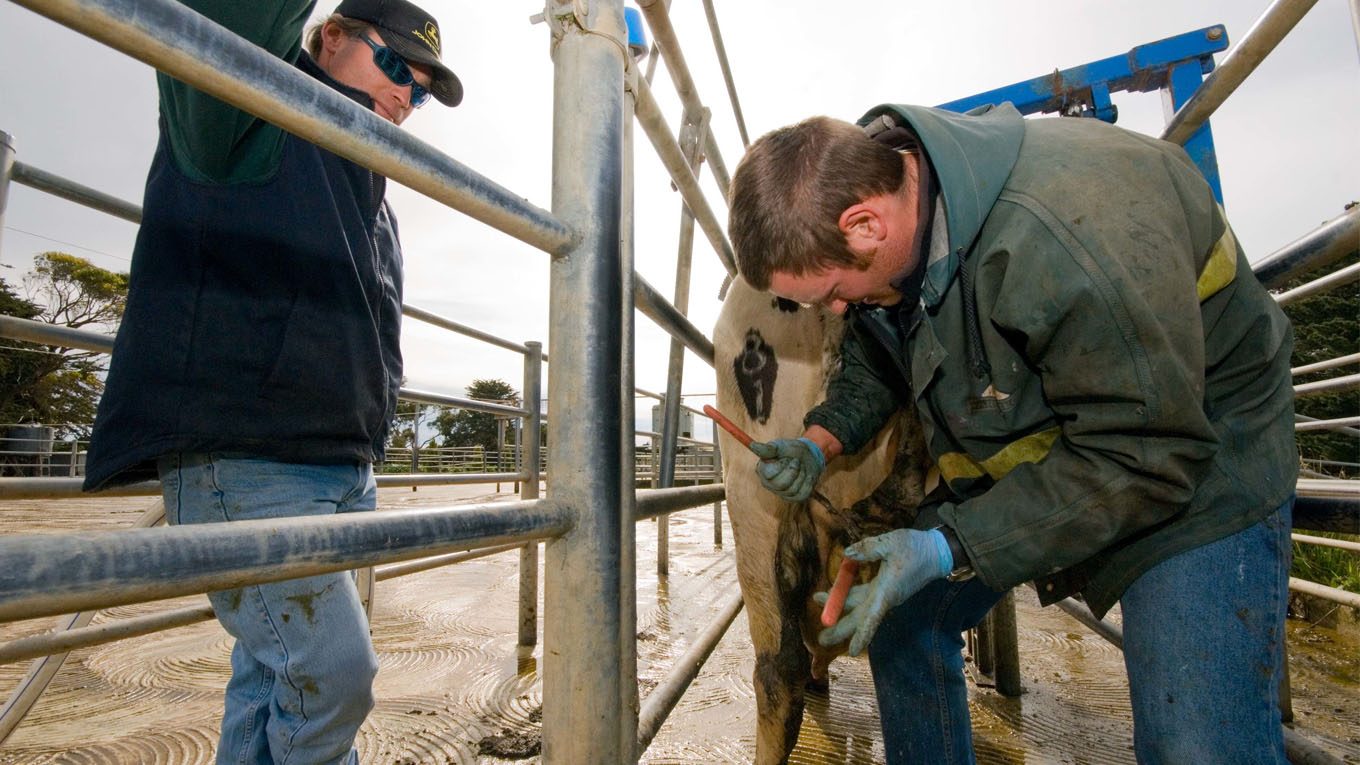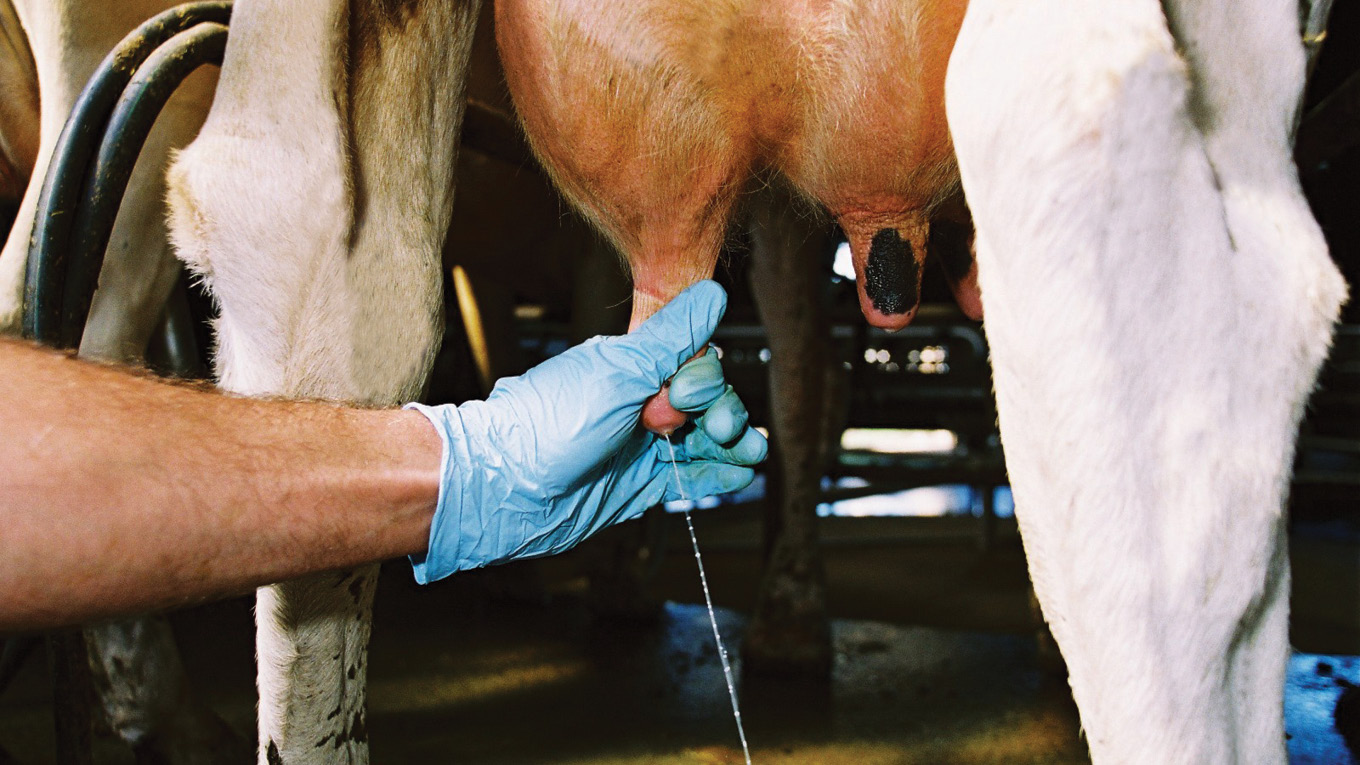Conditions of the Digestive System
There are a number of common conditions which affect the digestive system of weaned or older dairy cattle. These conditions include:
- Displaced abomasum (sometimes also called LDA, RDA or twisted stomach)
- Salmonella
- Yersinia
- Rumen acidosis
- Bovine Johne's Disease
- Bloat
- Woody tongue
More information about calf scours can be found on the calf scours page.
Displaced abomasum (LDA or RDA)
The term displaced abomasum is used to describe conditions where the abomasum (the animal's fourth stomach) becomes displaced from its normal position on the lower right-hand side of the abdomen. The displacement may either be on the left (left displaced abomasum or LDA) or on the right (right displaced abomasum or RDA). The condition may also sometimes be called a twisted stomach. An LDA is much more common than an RDA.
What to look for
Symptoms of cattle with LDA include:
- Decreased milk production
- Reduced appetite
- May be a lower volume of soft or pasty manure
- Usually affects freshly calved cows, less than one month after calving
- May be other diseases such as milk fever, retained placenta or lameness
Symptoms of cattle with RDA include:
- Cow becomes rapidly unwell
- Sudden drop in milk production
- Abdominal pain which may see the animal lying down, kicking its belly or looking at its flank
- May be cold to touch due to shock and have sunken eyes
- May be enlargement of the abdomen on the right-hand side
Cause
Left and right displaced abomasum are non-infectious conditions caused by reduced rumen fill and reduced activity of the abomasum. The condition may occur as a complication of other diseases such as rumen acidosis, milk fever, retained placenta or lameness. Good transition cow management is important for prevention of left and right displaced abomasum.
Animals likely to be affected
Most cows with a left or right displaced abomasum will have calved less than one month before developing the condition. Cows fed a high-concentrate, low-fibre diet are at higher risk of displaced abomasum.
Confirming the diagnosis
The diagnosis of left or right displaced abomasum requires examination by a veterinarian. The veterinarian will listen to the abdomen with a stethoscope and may flick the ribs to look for a characteristic 'ping' sound on either the left or right-hand side. It can sometimes be difficult to distinguish between a gassy rumen (the animal's second stomach) and a displaced abomasum. Therefore, the veterinarian may take a sample of fluid from the abdomen or blow down a stomach tube whilst listening with a stethoscope.
Treatment
A suspected RDA is a veterinary emergency. Left and right displaced abomasum are treatable surgically by a veterinarian.
There are several different surgical techniques for the treatment of LDA. The choice will depend on both the specifics of the case and the veterinarian’s preference. Rolling may be used to correct LDA but re-occurrence is very common if it is not combined with a surgical technique such as stitching or “toggling” the abomasum to the abdominal wall.
Additional supportive treatments such as propylene glycol (also known as pink drench), fresh cow powders, IV fluid therapy and anti-inflammatories may also be given.
The prognosis for cows with an LDA corrected surgically ranges from good to excellent. Cows that are very unwell with RDA have a poor prognosis even with surgery and should be humanely euthanased.
Risk factors
- Freshly calved cows, within one month of calving
- Inadequate transition cow management
- High-concentrate, low-fibre diets
- Other diseases such as rumen acidosis, milk fever, retained placenta or lameness
Prevention
Good transition cow management is the most important way in which to prevent left and right displaced abomasum. More information about transition cow management can be found on the transition cow management page.
Salmonella
This section describes salmonella in adult cattle. Information about salmonella in calves can be found on the calf scours page.
Important note: Salmonella can infect humans (called a zoonotic disease), so particular care should be taken with personal hygiene when handling affected animals.
What to look for
- Sudden drop in milk production
- Foul-smelling diarrhoea which may contain gut lining
- Animals are lethargic and obviously unwell
- Sunken eyes caused by dehydration
- May have a high temperature (greater than 39.5°C)
Salmonella can also cause abortion, meningitis, joint infections and pneumonia.
Cause
Salmonella is caused by bacteria of the Salmonella species. There are several different species of salmonella affecting cattle.
Animals likely to be affected
Salmonella may occur in dairy cattle of all ages.
Confirming the diagnosis
A diagnosis of salmonella requires laboratory testing of a manure sample.
Spread of the disease
Salmonella may be spread by direct contact between infected animals, by contamination of feed or water sources and contamination of the environment. Salmonella organisms can survive for long periods of time in the environment.
Importantly, some animals may become carriers of salmonella and are a permanent source of infection within a herd.
Treatment
Treatment for early cases of salmonella usually involves treatment with a broad-spectrum antibiotic. More severe cases will often require veterinary treatment with IV fluid therapy. Affected animals should be isolated to reduce spread of the disease.
Antibiotic resistance in salmonella bacteria is a serious human health problem worldwide. As salmonella can be transferred from infected cattle to humans, it is important to take care with the choice of antibiotic. To do this, manure samples from affected cows should be tested to confirm the presence of salmonella and identify any antibiotic resistance.
Ceftiofur (an antibiotic with a nil milk withholding period) should only be used to treat salmonella based on laboratory testing and never be used for mass medication.
Risk factors
- Contamination of the environment by affected or carrier animals
- Contamination of feed or water by birds and rodents
- Stressful events such as calving, overcrowding or sudden dietary changes
- Purchasing animals with an unknown health status
- High rates of grain feeding
- Supplementing with high rates of magnesium oxide
- Liver fluke infection
Prevention
Prevention of salmonella should include practicing good biosecurity and avoiding contamination of feed and water by infected animals.
A vaccine is available in Australia against two salmonella species, Salmonella typhimurium and Salmonella dublin. Before considering vaccination, it is important to confirm these species are involved in salmonella cases on your farm.
Vaccination of cows pre-calving may provide some protection to calves. However, this requires excellent colostrum management to be effective. More information about colostrum management is available on the rearing healthy calves page.
Yersinia
What to look for
- Diarrhoea in weaned young stock between six to 12 months of age
- Poor growth rates or ill-thrift
- Lethargy, depression and dehydration
Cause
Yersinia is caused by a bacterial organism called Yersinia pseudotuberculosis.
Animals likely to be affected
Young stock between the ages of six to 12 months are most likely to be affected. Yersinia occasionally occurs in younger and adult animals.
Confirming the diagnosis
A diagnosis of yersinia requires laboratory testing of a manure sample.
Spread of the disease
Yersinia may be spread by direct contact with infected animals and by contamination of the contamination of the environment by infected animals.
Treatment
Early cases of yersinia usually involves treatment with an antibiotic.
Risk factors
- Cold, wet weather
- Inadequate nutrition
- Infection with intestinal worms
- Stress, such as times of weaning, yarding or transport
Prevention
Addressing the risk factors above and ensuring good nutrition may be helpful in preventing yersinia. Dairy Australia's Heifers on Target resources can be used to assess whether the diet is meeting the nutritional needs of young stock.
Rumen acidosis
For information on rumen acidosis visit the Ruminal Acidosis page.
Bovine Johne’s Disease (BJD)
More information on Bovine Johne’s Disease (BJD) is available on the BJD page.
Bloat
There are two forms of bloat:
- Pasture bloat (also known as frothy bloat)
- Bloat secondary to other disease (e.g. abscess or infection around the nerves controlling the rumen)
This section describes pasture bloat.
What to look for
- Sudden death with very enlarged abdomen
If found before death:
- Enlarged abdomen on the left-hand side
- Difficulty breathing
- Abdominal pain demonstrated by bellowing, kicking the belly, standing up and lying down
- In milder cases, reduced milk production or growth rates of young stock
Cause
Bloat can be caused by consumption of lush, immature legumes such as clover or lucerne, or pasture and crops with high protein and low fibre levels. It is also occasionally associated with feeding of finely ground grain. This causes gasses to be trapped in the rumen by the formation of foam in the rumen which is unable to be burped out by the cow.
Animals likely to be affected
All grazing dairy cattle are susceptible to bloat.
Confirming the diagnosis
Sudden death of multiple animals grazing lush immature legumes, pasture or crops with very enlarged abdomens is strongly suggestive of bloat. Post-mortem examination of an animal that has died recently by a veterinarian will reveal characteristic foam in the rumen. In animals that are still alive, gas is unable to be released when a veterinarian passes a stomach tube.
Treatment
Emergency rumenotomy (also known as a bloat stab) may be required to save a severely affected animal’s life. These animals will be severely distressed, having difficulty breathing with the tongue hanging out. Farmers will need to call their veterinarian immediately to repair the wound and administer antibiotics to counter infection.
Mildly to moderately affected animals may be treated with a bloat drench.
Other animals should be moved off the at-risk pasture and given hay or silage.
Risk factors
Consumption of lush, immature legumes such as clover or Lucerne, or pasture and crops with high protein and low fibre levels.
Prevention
The most effective preventative is administering anti-foaming agents, special detergents or rumen modifiers. This may be achieved by:
- Feeding bloat prevention in the bail
- Adding bloat prevention to drinking water
- Spraying at-risk pasture with bloat oil
- Bloat blocks
- Drenching twice a day with bloat prevention products
- Applying bloat oil to the flank
The effectiveness of the preventative measures listed is variable. Farmers should consult with their veterinarian or nutrition advisor to decide which option is best for their herd.
Woody tongue
What to look for
- Pain and difficulty eating and swallowing
- Drooling
- Swelling under the jaw
Cause
Woody tongue is caused by a bacterial organism called Actinobacillus lignieresi. This bacteria is normally present in the mouth of cattle but causes infection of the tongue following trauma or abrasions to the tongue.
Animals likely to be affected
Dairy cattle of any age can be affected by woody tongue.
Confirming the diagnosis
A diagnosis can be made by examining the tongue for pain, swelling and firmness. Ulcers may also be observed on the tongue.
Treatment
Treatment for woody tongue involves an injection with sodium iodide by a veterinarian and/or a long course of a broad-spectrum antibiotic. Sodium iodide may cause abnormalities of the coat and eyes, and occasionally abortion if used in late pregnant animals.
Risk factors
- Consuming course forages containing fibrous stalks
- Volcanic or gravelly soils
Prevention
There is no specific prevention for woody tongue.


